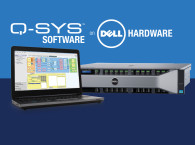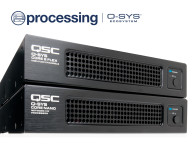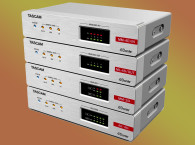“CXD-Q represents our ongoing commitment to create installed sound solutions that are incredibly versatile and integrate seamlessly with Q-Sys,” says Dale Sandberg, QSC Senior Product Manager. “As Q-Sys products, they operate like other Q-Sys peripherals utilizing the same standard Layer 3 networking technology for audio streaming, control, and monitoring. As amplifiers, they feature our new Flexible Amplifier Summing Technology (FAST) that enables the amp channels to be combined and deployed in a wide-range of installed sound applications. This allows integrators the ability and flexibility to design and install systems in a whole new way.”
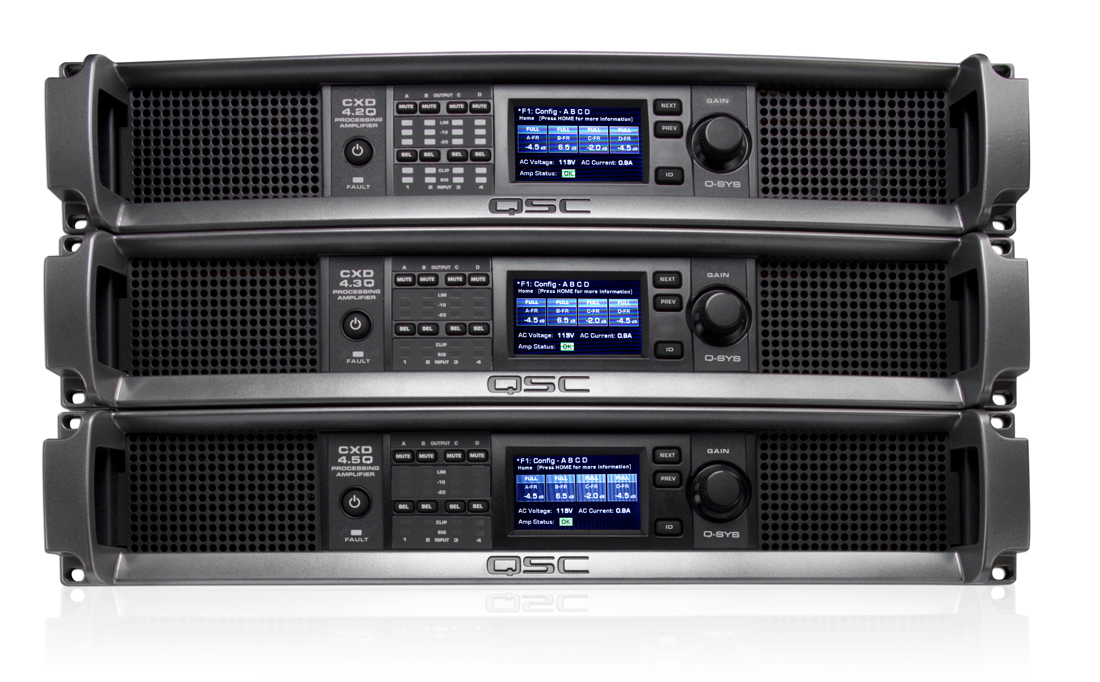
Redundant rear-panel Ethernet jacks on the amplifiers makes Q-Sys integration as simple as connecting a standard off-the-shelf Ethernet cable. Like other Q-Sys peripherals, adding CXD-Q amplifiers to a new or existing Q-Sys design is easily done via the Q-Sys Designer Schematic Page. Moreover, the on-board Mic/Line inputs are audio on-ramps onto the Q-Sys network, providing routable inputs to anywhere in the facility.
Housed in a 2U rack-mount configuration, CXD-Q Network Amplifiers feature new QSC proprietary class-D power devices, which enable multi-channel, high performance power. The CXD-Q lineup includes the CXD4.2Q (400W/CH @ 4 ohms continuous, 500W/CH burst), the CXD4.3Q (625W/CH @ 4 ohms continuous, 1600W/CH burst) and the CXD4.5Q (1250W/CH @ 4 ohms continuous, 2000W/CH burst) with the CXD4.3Q and CXD4.5Q able to direct drive 70V and 100V systems. The innovative FAST technology provides better power allocation by distributing the total amplifier power across one, two, three or all four outputs enabling amp channels to be combined for maximum current or voltage output. The largest models are capable of up to 5,000 watts continuous and peaks of up to 8,000 watts.
The rear panels feature four (4) balanced Euroblock Mic/Line input connectors that are onramps into the Q-Sys system, and four (4) Euroblock touch-proof loudspeaker connectors enabling integrators to terminate wiring before connecting to the amplifier, while GPIO connectors offer additional functionality. In addition to their outstanding efficiency, the CXD-Q amplifiers’ power saving modes further ensure that energy costs will be kept to a minimum over the life of the installation.
AES67 on Q-Sys
QSC announced that the latest software release for the Q-Sys Network Audio platform, Designer v4.0, now meets AES67 network clock and audio packet delivery standards. The company has further stated that all future Q-Sys software releases will also be fully compliant with AES67 interoperability mode.
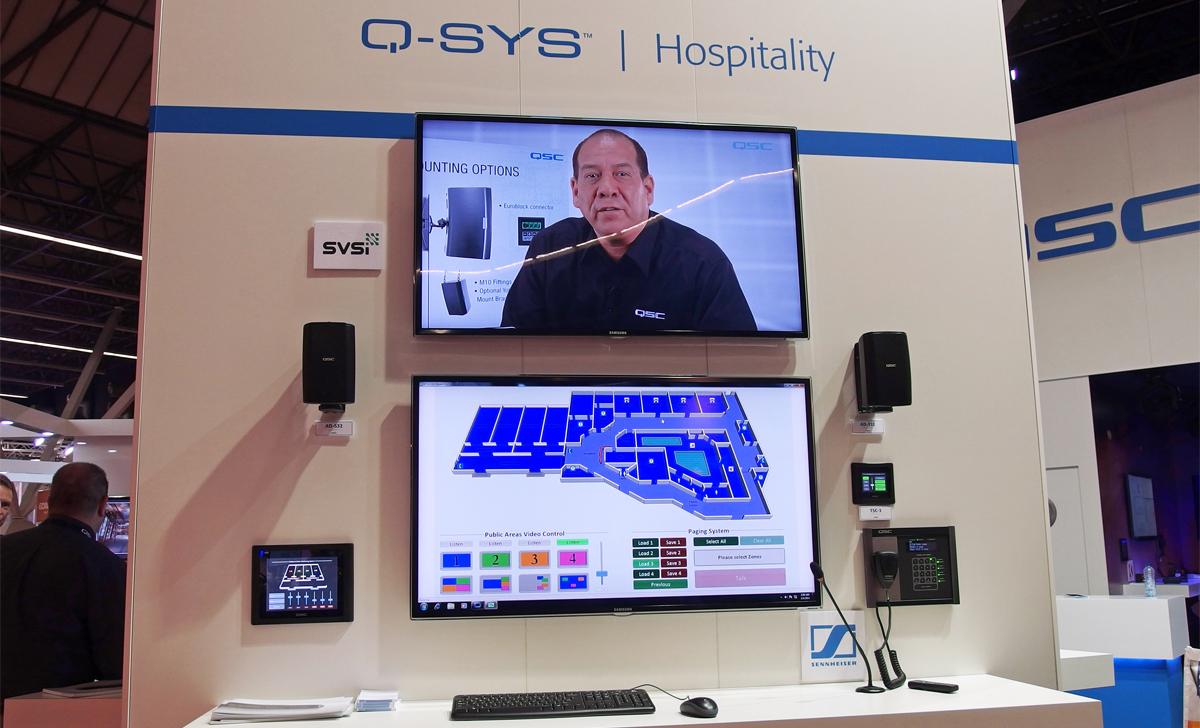
“Industry-standard network audio protocols have been somewhat of a misnomer,” says TJ Adams, QSC Install DSP Product Manager. “What some people refer to as an Industry-standard may actually rely on proprietary hardware, and what some people refer to as proprietary may actually employ very common IT standards. AES67 now clearly defines an open standard protocol for the entire professional audio community that is truly IT-friendly.”
As charter members of the Audio Engineering Society’s X192 task group (which has now become AES67:2013), QSC demonstrated to the broader professional audio community its commitment and support of open standards that benefit the industry as a whole. As QSC explains, “The AES has long been the established voice for standards in the professional audio community, and the recent ratification of their AES67 standard for high-performance audio-over-IP interoperability is the culmination of years of bipartisan work by dedicated audio and IT professionals. This open standard now provides the entire professional audio community with protocols that will enable A/V integrators and IT professionals everywhere to better integrate and manage their interdependent systems.”
New Q-Sys Cores
At the center of QSC’s audio network platform are the new generation Q-Sys Enterprise Cores. Doubling the processing capabilities of the models they supersede (Core 1000 and Core 3000), the new Core 1100 provides up to 256x Q-LAN network audio Flex-channels, while the Core 3100 provides up to 512x512 fixed Q-LAN network audio channels.
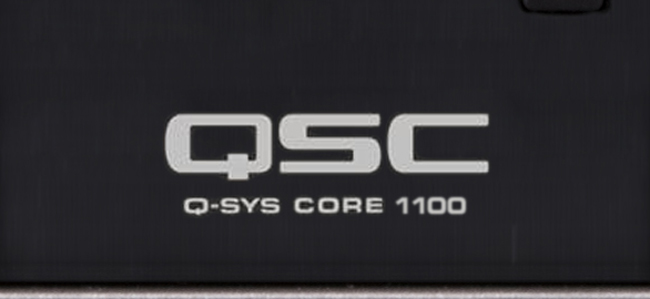
“These next-generation server cores are uniquely suited to manage the extensive audio processing needs in larger deployments such as convention centers, entertainment venues, hospitality settings and transportation facilities,” states TJ Adams, QSC Install DSP Product Manager.
With the launch of the new Q-Sys Cores, QSC has also updated its software Q-Sys Designer to version 4.0, supporting both new and existing Q-Sys Cores. Q-Sys Designer 4.0 includes many new software features such as Core-to-Core paging which allows individual cores to seamlessly transmit messages across a campus-wide installation, Timeline Playback, plus an all new Dynamic Threshold Auto-mixer.
Also included in this major software release are greater Scripting capabilities as well as enhancements to existing Q-Sys features such as the Notch Feedback Controller, Scheduler, Acoustic Echo Canceller, I/O Monitor and Audio Playback capabilities, which have been augmented to include Fast-Forward, Rewind and Synchronization to LTC and GPS.
Dante Bridge
Q-Sys platform uses its own third-generation networked media distribution technology, Q-LAN, as a central component of its integrated system platform. Apart from the AES 67 interoperability announcement, QSC also offers the new CDN64 Dante bridge card to provide third-party Dante enabled digital audio products the ability to connect and interface with Q-Sys while maintaining low latency.
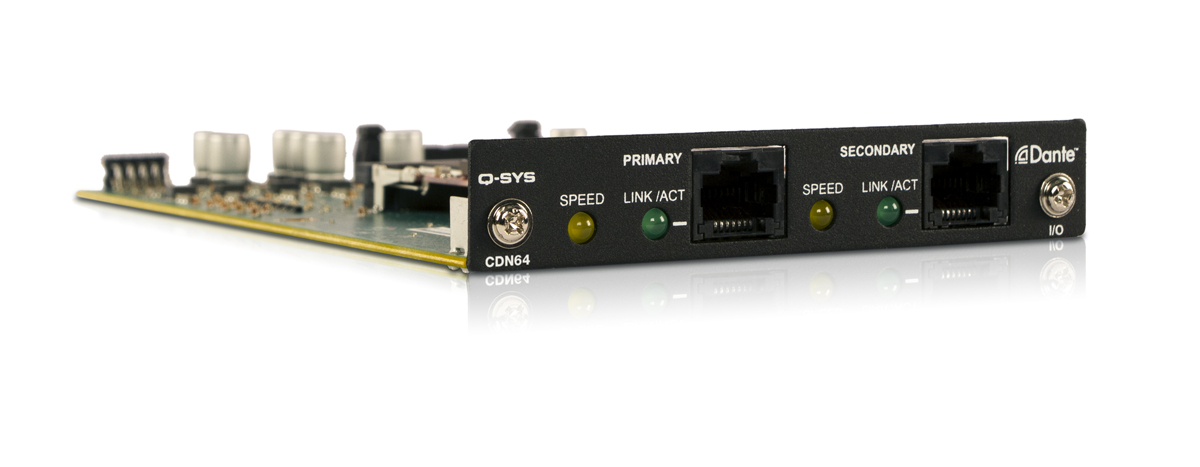
“In the past few years we have experienced tremendous growth in the number of Q-Sys Network Audio systems installed worldwide into performance venues such as theatres, auditoriums and houses of worship, and in some cases our Q-Sys customers have requested a solution to bridge their Dante-enabled sources, such as wireless microphones and digital mixers, directly onto their Q-Sys network,” says David Fuller, Sr. Director of Technical Marketing & International Sales.
“We have observed that Audinate’s Dante hardware has been a popular protocol with many high-end live-sound manufacturers, and with the introduction of our new CDN64 bridge card, our customers are now able to interface their Dante-enabled ‘front-of-house’ input sources with their ‘back-of-house’ or ‘facility-wide’ Q-Sys solution.”
The CDN64 provides a bridge for 64x64 channels at 48 kHz (32x32 channels at 96 kHz) from any Dante edge network, directly into a QSC Q-Sys Core for advanced processing and re-distribution over larger LAN and WAN IT infrastructures.
qsc.com



